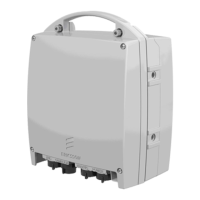3-9 MINI-LINK BAS
EN/LZB 111 0542 P2B Technical Description
3.3 System Synchronisation
MINI-LINK BAS access network needs to be synchronized to the
backbone networks in order to interoperate correctly with them.
Interoperation with a PSTN is strictly related to the services provided
which imply isochronous operations and timing transparency from the
Local Exchange till Customer Premises Equipments (CPEs).
Even the SDH/ATM backbone network requires synchronous
operation, at least at link level. The timing of PSTN and SDH/ATM
backbone derive from a Primary Reference Clock (PRC) – eventually
this PRC clock could be unique.
In order to face different network scenarios the system allows the
choice of any port in the system – both PDH synchronous and SDH –
for synchronization purpose. In principle, because of the synchronous
CES support, the best choice is to use synchronous PDH references as
isochronous operation where the PSTN network is inherently assured.
The use of SDH ports for synchronization is also a suitable choice
since once timing of SDH network and PSTN network are traceable to
the same PRC. If it is not the case and the two networks are traceable
to separate PRC, byte slips would be experienced for the PDH service,
which rate is anyway limited to less than 1 slip every 72 days.
Slips are not due to the system behaviour but are due to the
plesiochronous operation of the backbone networks.
Asynchronous PDH ports are not suitable for network synchronization
and their use is not allowed for synchronization purpose.
The lack of a network reference will make the system operate in the
free running mode: the port selected for synchronization will keep
synchronizing the system exploiting the on board internal reference,
that features a Stratum 4 clock accuracy, that is better than 32 ppm.
The port selected for synchronization is monitored against failures,
synchronization specific alarms are reported to the operator to allow
manual recovery of the failure. Guidelines and procedures are given in
the proper section of the user documentation.
The system does not foresee any dedicated port for network
synchronization from office clock distributors.

